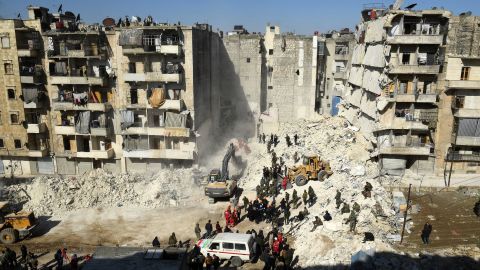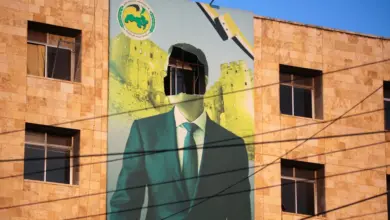
Drone footage and satellite imagery have conveyed the stark reality of widespread destruction in an area that straddles two very different nations.
The scale of the disaster is enormous. “We’ve done a bit of mapping of the size of the affected area,” said Caroline Holt, director of disasters, climate and crises at the International Federation of the Red Cross (IFRC). “It’s the size of France.”
United Nations Secretary-General António Guterres said Thursday that “we haven’t yet seen the full extent of the damage and of the humanitarian crisis unfolding before our eyes,” while estimates from the World Health Organization suggest up to 23 million people could be impacted by the natural disaster.
Once search efforts have ended, attention will turn to longer-term reconstruction. Turkey has suffered earthquakes in the past, and has rebuilt. But how much can be learned from this history and will these lessons be implemented? And will the same efforts be matched across the border?
History repeating itself in Turkey
The death toll broke the grim milestone of 22,000 on Friday. As it continues to climb, so too have feelings of anger and resentment. Turkey is no stranger to earthquakes and many feel that the government failed to prepare for another catastrophic event.
This frustration dogged Turkish President Recep Tayyip Erdogan as he made a whistle-stop tour of the Kahramanmaras region – near the epicenter of the deadly earthquake – on Wednesday and Thursday. Erdogan defended his government’s response, admitting to “shortcomings,” before stressing that it’s “not possible to be prepared for such a disaster.” He also announced that the government’s target was to rebuild “in one year,” though experts told CNN it could take much longer.
Major earthquakes such as these are infrequent, but many in Turkey are still harrowed by memories of the 1999 Izmit earthquake in the Marmara region.
Ajay Chhibber, an economist who was World Bank director for Turkey when that 7.6 magnitude quake struck two decades ago, told CNN that “it’s like a bad movie [that’s] come back again.” Similar to this week’s event, that tremor struck in the early hours but it occurred in the country’s northwest – a densely populated area closer to Istanbul. He said it lasted around 45 seconds, leaving more than 17,000 dead and an estimated 500,000 people homeless.
Flying into the region in the immediate aftermath, Chhibber told CNN he “hadn’t seen that much devastation before.” He recalled traveling in with the Japanese and German ambassadors at the time, who told him “this looks to us like World War II.”
Buildings “flattened like pancakes” were among the apocalyptic scenes Chhibber encountered in 1999. In the city of Golcuk, where a naval base was located, he remembered seeing “submarines that were tossed up out of the water, lying 300, 400 feet up a mountain.”
“You could see submarines sitting there. It was unbelievable. And what I’m seeing now is just a redo,” he said.
Some may question if the Turkish president’s current target of a year for reconstruction is achievable, given he also said that more than 6,000 buildings had collapsed. But Chhibber pointed out that “Turkey is capable of moving very, very swiftly – if they can get their act together on this.”
Chhibber helped implement a four-part recovery plan in the wake of the 1999 disaster that provided cash to residents, aided in reconstructing infrastructure and housing, established an insurance system and developed an organizational system that cascaded from a national level down to the community for overall coordination efforts.
“Compared to disasters around the world, it was one of the most rapid reconstruction and recoveries that I ever saw,” Chhibber said. He added that the majority of the work was completed in two years.
Ismail Baris, professor of social work at Istanbul’s Uskudar University and former mayor of Golcuk at the time of the quake, told CNN in an email that “in addition to the collapsed private and public buildings, the city’s water transport pipes, water supply network, sewage system [and] storm water system were completely destroyed,” as well as 80% of the city’s roads. He added that the full reconstruction of the city took four years.
However, much of the reconstruction then was aided by the Turkish army, which was brought in when many local administrations collapsed. Chhibber said this enabled the rubble clearing to be done quickly.
“But Izmit is in the heartland of Turkey,” said Chhibber. Many Kurds live in the areas hit by the earthquake and bringing in the army may cause problems.
“This is a huge challenge,” said Ilan Kelman, professor of disasters and health at University College London. While the army has the personnel and resources, “they also have the unfortunate history of often abusing their power,” Kelman told CNN.
“The Kurds in that region and many Turks in that region, understandably, would be very hesitant to have the army in the streets even more than they have been,” he said.
Experts said there also needs to be a review of what went wrong. The country has strict rules that came into place after 1999 – construction regulations were implemented that required the more modern builds to be able to withstand these quakes. Yet many of the apartment blocks within the earthquake zone appeared to have been newly-constructed and still collapsed.
Sinan Ulgen, a Turkish former diplomat currently chairing the Istanbul-based Centre for Economics and Foreign Policy, said there had been awareness regarding the preparations that still needed to be done but that “unfortunately over the past two decades, this has remained mostly on paper.”
“There was a special fund with taxes raised for rehabilitation of cities to withstand these types of natural disasters. Some of that money got squandered, didn’t go to the right places. And then the lack of enforcement, which is really the big liability,” Ulgen told UK broadcaster Channel 4. “The regulations have certainly been improved … but it’s really a matter of enforcing those regulations. And there, Turkey really needs to upgrade its game.”
Chhibber too said Turkey hadn’t learned enough from the lessons of the past and questioned why there was a failure to enforce building regulations. He said the Turkish government had regularly allowed for so-called “construction amnesties” – essentially legal exemptions that, for a fee, allowed for projects without the necessary safety requirements. The most recent amnesty was passed in 2018.
He said building amnesties were “a huge issue.”
“They just go ahead and make the building. They don’t follow the code. They know that at some point some politicians – because they’re financing their political parties – they’ll grant them an amnesty. That’s a huge problem.”
Turkey’s justice minister said Friday that investigations into builders in earthquake regions had begun, according to Turkish state media Anadolu. “As a result, as I said, whoever has faults, negligence or deficiency will be brought to justice and they will be held accountable before the law,” Bekir Bozdağ said.
Syrian crises pile up
Across the border in Syria, rebuilding efforts will be even more complicated. Guterres warned Thursday that Syrians face “nightmares on top of nightmares,” and the World Food Programme has described the situation in the northwest of the country as a “catastrophe on top of catastrophe.”
“We have the perfect humanitarian storm in Syria,” said Caroline Holt, IFRC director for disasters, climate and crises.
The UN estimates more than four million people were already dependent on humanitarian aid in the worst-affected parts of rebel-controlled Syria, due to the civil war that has ravaged the country since 2011. When the earthquake struck there, many traumatized residents first wondered if they were being woken by the sound of warplanes once again.
“After 12 years of constant pain, suffering and living in a vulnerable context, your ability to withstand – especially in winter – the harsh conditions that you’re facing [is diminished],” Holt told CNN.
In Syria, political fault lines run deep. Some of the areas most impacted by the earthquake are controlled by the Assad regime, others by Turkish-backed and US-backed opposition forces, Kurdish rebels and Sunni Islamist fighters. These political divisions create logistical knots. Negotiating them will frustrate recovery efforts.
“The conflict – or conflicts – are much worse in that area of Syria than in that area of Turkey,” Kelman said.
While Turkey has political problems of its own, “they do have a comparatively strong government and comparatively strong military in comparison to Syria, which is at war,” he added.
Turkey also has greater “pre-earthquake resources,” Kelman said. “Neither country is especially rich, but Turkey at least has that baseline where they’ve not been in a major conflict dividing the country for 12 years. They have not been isolated through sanctions.”
The sanctions have created geopolitical obstacles that humanitarian aid has to maneuver around. The Assad regime insists that all aid to the country, including aid that is meant for areas outside its control, be directed to the capital Damascus. The Syrian government on Friday approved sending aid into rebel territory in the northwest, according to a statement, but provided no timeline for delivery.

But the regime has long siphoned off aid intended for rebel-controlled regions. As such, relief workers attempting to clear the rubble depend on resources sent via a single road, the Bab al-Hawa crossing – the only humanitarian aid corridor between Turkey and Syria.
The result is that “most of the work is done by hand,” according to Mohammad Hammoud, Syria manager for the Norwegian Red Cross. Hammoud told CNN how Syria lacks the machinery available to Turkey – and the little machinery they have has no fuel to run on, after supplies from Damascus were shut off. “We are mainly reliant on manpower,” he said.
These discrepancies mean Syria’s recovery is likely to progress along a stunted timeline. Given its lack of coordination, basic questions may go unanswered for some time.
“It’s about, first of all, removing the debris and the rubble. What do you do with that? It can either become an environmental hazard, or it can become an asset, if you choose to pave roads with it,” said Holt.
The IFRC director estimates that in Turkey much of the recovery work will be done within two to three years. But in Syria, “we’re looking at a five to 10-year frame just to get recovery underway,” she said.
The years ahead
While disasters like this wreak havoc, they also create opportunities to prevent such havoc being wrought again. There is a man-made part of every natural disaster, according to Chhibber.
Earthquakes are inevitable; their effects are not. Chhibber said he saw this point illustrated after the Izmit earthquake in 1999. “You’d have one building completely erect, the next building completely flat like a pancake.” The same sights can now be seen in Turkey’s Gaziantep.


For Chhibber, this is the result of choices. “There is an earthquake, but it need not be a disaster to this scale, unless it’s man-made. And the man-made part comes from the lack of a proper building code being enforced. There’s no reason these buildings should have collapsed that easily. Some of them were built only a year or two ago,” he said.
Kelman also stressed that disasters create the opportunity for things to be done differently. He hopes the quake can be used as a spur for “disaster diplomacy,” which asks “whether or not dealing with disasters in any way can end conflict and create peace.”
However, not all governments choose to take these opportunities.
Related article: How to help victims of the earthquake in Turkey and Syria
“We do have examples where people have taken the opportunity to say there has been a disaster, and we want to help people, so let’s try to reconstruct in such a way that we are supporting peace,” Kelman said.
“At the moment, I do not see either government responding in that way, and I do not see the world responding in that way.”
CNN’s Isil Sariyuce, Reyhan Baysan, Hande Atay Alam, Nadeen Ebrahim, Dalya Al Masri, Mostafa Salem and Eyad Kourdi contributed to this report.




